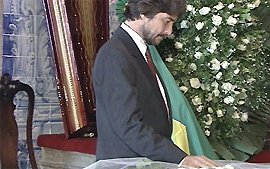part IV
In Brazil, young Pedro II was kept in ignorance as to most of the events faced by his sister in Lisbon. The child emperor was placed under a regency until he reached the age required by law to begin his reign without supervision. In an effort to avoid Pedro II becoming a philandering womanizer, as his father had been, his tutors centered on raising his conscientiousness and morality. They also built within Pedro and his sisters a deep love and respect for the historical figure represented by their long-suffering mother. In doing so, the tutors of the imperial children turned Empress Leopoldina into a semi-divine figure who would be an ever present part throughout the life of Pedro II in particular.
The regency came to an end in 1840, when young Pedro, by then a tall, blue-eyed Germanic youth, was but fifteen years of age. Brazilian politicians had engulfed themselves in an increasing power struggle which was leading the empire to ruin. To put an end to political squabbling it was decided that Pedro II's majority would be declared before it was due. Doing so, the politicians believed, would allow the emperor to play a mediating role in the constant power struggles of the country's leading political parties. Soon after Pedro II's coronation the royal succession once again became an issue. The Braganzas had been very good at producing offspring, unfortunately for the dynasty most of these children were little Infantas. According to the laws of succession in Brazil, women would only succeed in the absence of a male prince. This also posed a problem concerning the search for suitable husbands for the emperor's sisters. For after all, these prospective husbands would have to be brought to Brazil and their children raised as Brazilian princes. In the 1840's not many European princelings were willing to travel halfway across to world to settle in an empire that at times seemed tittering on the brink of collapse. Hence, Pedro II had to be married off very soon to perpetuate the existence of the dynasty into the future.
Emissaries were sent to Europe. The main royal courts were visited and the results were less than satisfactory. Not only was there an absence of marriageable princesses, but those who remained unmarried were of a less than attractive nature. The Brazilian emissaries, rebuffed by the principal European courts, then headed to those which were not as politically relevant. One of these minor kingdoms was located in the city of Naples, where a branch of the Spanish royal family had ruled for over a century as Kings of the Two Sicilies. In fact, Pedro II's great-grandfather, King Carlos IV of Spain, was a brother of Ferdinand I of the Two-Sicilies, grandfather of the princess who was chosen as Pedro II's bride. Princess Theresa of the Two-Sicilies, a quiet and unpretentious soul, did not inherit any of the good looks held by some members of her family. It has been said that upon meeting his bride for the first time, the day before their marriage, Pedro II was simply dismayed at having to share his future with such an unbecoming royal bride. "They deceived me...I can't make her my wife. She is terrible," a deeply upset Pedro moaned . One of his tutors is purported to have reminded Pedro of the sad fate of his own mother and of his cavalier obligation towards fulfilling the needs of the imperial nursery. Nonetheless, and regardless of his misapprehension concerning Theresa, Pedro II married his Neapolitan cousin and settled to the procreation of a new generation of Braganza infants. Pedro's sisters, Francisca and Januaria, also married European princes at about the same time. Francisca of Braganza was married to Prince Philippe of Bourbon-Orleans, the fourth son of King Louis-Philippe of France; Januaria of Brazil was married to Prince Louis of the Two-Sicilies, Count of Aquila, brother of Empress Theresa.
Within a year of their marriage, Pedro II and Theresa were the parents of a little boy. Prince Affonso of Brazil was born in 1845 and his arrival brought a further closeness to the loveless union of his parents. One year later another child arrived, Princess Isabel. Yet, the imperial couple's increasing domestic happiness was seriously affected by the untimely death of their firstborn in 1847. The little Prince Affonso was found dead in his crib, without any apparent medical reason for this most unexpected event. the initial sadness caused by Affonso's death was lifted by the birth of a third child in that same year, Princess Leopoldina. Pedro II's sadness at the loss of his only male child was relieved by the birth of a second son in 1848, Pedro, Prince Imperial of Brazil. However, within two years of this happy event, death would take the little prince away. Desolate by the death of his son, Pedro II penned a sonnet in which his utter frustration was revealed:
"Twice have I already suffered death,
For the father dies, whose eyes see his son dead.
Mine is the most dismal of fates:
During sweet infancy I lacked father and mother--
And now my own small sons are gone."
After the loss of their second son, Pedro and Theresa were unable to have any more issue. The emperor resigned himself to having his daughter Isabel created Princess Imperial of Brazil, the official heiress of the empire. His inner sadness was extemporized by the abandoning of former court festivities and the transformation of his entourage into a serious and hardworking enterprise. The emperor gradually abolished many of the ceremonies that had previously demanded great pomp and circumstance, while also opening the imperial family to more contact with a larger number of Brazilian subjects.
In Brazil, young Pedro II was kept in ignorance as to most of the events faced by his sister in Lisbon. The child emperor was placed under a regency until he reached the age required by law to begin his reign without supervision. In an effort to avoid Pedro II becoming a philandering womanizer, as his father had been, his tutors centered on raising his conscientiousness and morality. They also built within Pedro and his sisters a deep love and respect for the historical figure represented by their long-suffering mother. In doing so, the tutors of the imperial children turned Empress Leopoldina into a semi-divine figure who would be an ever present part throughout the life of Pedro II in particular.
The regency came to an end in 1840, when young Pedro, by then a tall, blue-eyed Germanic youth, was but fifteen years of age. Brazilian politicians had engulfed themselves in an increasing power struggle which was leading the empire to ruin. To put an end to political squabbling it was decided that Pedro II's majority would be declared before it was due. Doing so, the politicians believed, would allow the emperor to play a mediating role in the constant power struggles of the country's leading political parties. Soon after Pedro II's coronation the royal succession once again became an issue. The Braganzas had been very good at producing offspring, unfortunately for the dynasty most of these children were little Infantas. According to the laws of succession in Brazil, women would only succeed in the absence of a male prince. This also posed a problem concerning the search for suitable husbands for the emperor's sisters. For after all, these prospective husbands would have to be brought to Brazil and their children raised as Brazilian princes. In the 1840's not many European princelings were willing to travel halfway across to world to settle in an empire that at times seemed tittering on the brink of collapse. Hence, Pedro II had to be married off very soon to perpetuate the existence of the dynasty into the future.
Emissaries were sent to Europe. The main royal courts were visited and the results were less than satisfactory. Not only was there an absence of marriageable princesses, but those who remained unmarried were of a less than attractive nature. The Brazilian emissaries, rebuffed by the principal European courts, then headed to those which were not as politically relevant. One of these minor kingdoms was located in the city of Naples, where a branch of the Spanish royal family had ruled for over a century as Kings of the Two Sicilies. In fact, Pedro II's great-grandfather, King Carlos IV of Spain, was a brother of Ferdinand I of the Two-Sicilies, grandfather of the princess who was chosen as Pedro II's bride. Princess Theresa of the Two-Sicilies, a quiet and unpretentious soul, did not inherit any of the good looks held by some members of her family. It has been said that upon meeting his bride for the first time, the day before their marriage, Pedro II was simply dismayed at having to share his future with such an unbecoming royal bride. "They deceived me...I can't make her my wife. She is terrible," a deeply upset Pedro moaned . One of his tutors is purported to have reminded Pedro of the sad fate of his own mother and of his cavalier obligation towards fulfilling the needs of the imperial nursery. Nonetheless, and regardless of his misapprehension concerning Theresa, Pedro II married his Neapolitan cousin and settled to the procreation of a new generation of Braganza infants. Pedro's sisters, Francisca and Januaria, also married European princes at about the same time. Francisca of Braganza was married to Prince Philippe of Bourbon-Orleans, the fourth son of King Louis-Philippe of France; Januaria of Brazil was married to Prince Louis of the Two-Sicilies, Count of Aquila, brother of Empress Theresa.
Within a year of their marriage, Pedro II and Theresa were the parents of a little boy. Prince Affonso of Brazil was born in 1845 and his arrival brought a further closeness to the loveless union of his parents. One year later another child arrived, Princess Isabel. Yet, the imperial couple's increasing domestic happiness was seriously affected by the untimely death of their firstborn in 1847. The little Prince Affonso was found dead in his crib, without any apparent medical reason for this most unexpected event. the initial sadness caused by Affonso's death was lifted by the birth of a third child in that same year, Princess Leopoldina. Pedro II's sadness at the loss of his only male child was relieved by the birth of a second son in 1848, Pedro, Prince Imperial of Brazil. However, within two years of this happy event, death would take the little prince away. Desolate by the death of his son, Pedro II penned a sonnet in which his utter frustration was revealed:
"Twice have I already suffered death,
For the father dies, whose eyes see his son dead.
Mine is the most dismal of fates:
During sweet infancy I lacked father and mother--
And now my own small sons are gone."
After the loss of their second son, Pedro and Theresa were unable to have any more issue. The emperor resigned himself to having his daughter Isabel created Princess Imperial of Brazil, the official heiress of the empire. His inner sadness was extemporized by the abandoning of former court festivities and the transformation of his entourage into a serious and hardworking enterprise. The emperor gradually abolished many of the ceremonies that had previously demanded great pomp and circumstance, while also opening the imperial family to more contact with a larger number of Brazilian subjects.
Last edited by a moderator:


